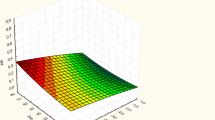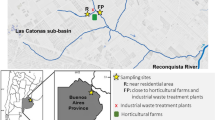Summary
1. Voltage-activated ionic currents of three identified neurons ofLymnaea stagnalis L. were compared in control snails and in animals having been exposed to a cadmium- or lead-enriched environment for 2 weeks. We determined the presence, amplitude, and changes, if any, in the current-voltage characteristics of calcium and potassium currents in each of the three neurons from each of the three groups of animals. Finally, we have compared the effects of acute administration of Cd2+ or Pb2+ on neurons from control and chronically exposed animals.
2. Chronic exposure to cadmium resulted in a near doubling of the high voltage-activated calcium current.
3. No differences were found in the effects of acute application of Cd2+ or Pb2+ on neurons of pretreated and control animals. Cadmium was a potent blocker of the Ca current in either case, while lead caused only a 20% inhibition of the Ca current in neurons of both control and lead-exposed animals.
4. Potassium currents were affected in both Cd2+- and Pb2+-exposed animals. While the sustained outward current was not influenced noticeably, the fast K current was affected in different ways in different neurons. Some did not show this current in the controls but expressed it in neurons from the exposed animals. Other neurons showed the current in the controls and its depression in exposed animals. Acute application of cadmium did not modulate the K current, but lead enhanced the peak amplitude of the transient K current in neurons of both exposed and control snails.
Similar content being viewed by others
References
Adler, M. W., and Adler, C. H. (1977). Toxicity of heavy metals and relationship to seizure threshold.Clin. Pharmacol. 22:774–779.
Atchinson, D. W., and Narahashi, T. (1984). Mechanism of action of lead on neuromuscular junction.Neuro Toxicology 5:267–282.
Audesirk, G. (1987). Effects ofin vitro andin vivo lead exposure on voltage-dependent calcium channels in central neurons of Lymnaea stagnalis.Neuro Toxicology 8:579–592.
Audesirk, G., and Audesirk, T. (1993). Effects of chronic low level lead exposure on the physiology of individually identifiable neurons.Neuro Toxicology 4:13–26.
Avery, D. D., and Cross, H. A. (1974). The effect of tetraethyl lead on behavior in the rat.Pharmacol. Biochem. Behav. 2:473–479.
Biondi, C., Fabbri, E., Ferretti, M. E., Sonetti, D., and Bolognani Fantin, A. M. (1989). Effects of lead exposure on cAMP and correlated enzymes in Viviparus ater (Mollusca, Gastropoda) nervous system.Comp. Biochem. Physiol. 94C:327–333.
Büsselberg, D., Evans, M. L., Rahmann, H., and Carpenter, D. O. (1990). Lead inhibits the voltage activated calcium current inAplysia neurons.Toxicol. Lett. 51:51–57.
Clarkson, T. W. (1987). Metal toxicity in the central nervous system.Environ. Health Perspect. 75:59–69.
Cooper, P. G., and Manalis, R. S. (1983). Influence of heavy metals on synaptic transmission.Neuro Toxicology 4:69–84.
Cooper, P. G., Suzskiv, J. B., and Manalis, R. S. (1984). Heavy metals: effects on synaptic transmission.Neuro Toxicology 5:247–266.
Hodgkin, A. L., and Huxley, A. F. (1952). A quantitative description of membrane current and its application to conduction and excitation in nerve.J. Physiol. (Lond.) 117:500–544.
Kostyuk, P. G., and Krishtal, O. A. (1977). Separation of sodium and calcium currents in the somatic membranes of mollusc neurons.J. Physiol. (Lond.) 270:345–568.
Nordberg, G. F. (1980). Neurotoxic effect of metals and their compounds. InAdvances in Neurotoxicology (L. Manzo, Ed.) Pergamon Press, London, pp. 3–15.
Osipenko, O. N., Kiss, T., and Salánki, J. (1992). Effects of Cu2+, Pb2+ and Zn2+ on voltage activated currents in Helix pomatia L. neurons.Environ. Monit. Assess. 22:57–72.
Press, W. H., Flannery, B. P., Teukolsky, S. A., and Vetterling, W. T. (1986).Numerical Recipes, Cambridge University Press, Cambridge, pp. 523–528.
Salánki, J. (1989). New avenues in the biological indication of environmental pollution.Acta Biol. Hung. 40:295–328.
Salánki, J. (1992). Heavy metal induced behaviour modulation in mussels: possible neural correlates.Acta Biol. Hung. 43:375–386.
Salánki, J., and Hiripi, L. (1990). Effect of heavy metals on the serotonin and dopamine systems in the central nervous system of the freshwater mussel (Anodonta cygnaea L.)Comp. Biochem. Physiol. 95C:301–305.
Salánki, J., Osipenko, O. N., Kiss, T., and Györi, J. (1991a). Effect of Cu2+ and Pb2+ on membrane excitability of snail neurons. InMolluscan Neurobiology (K. S. Kits, H. H. Boer, and J. Joosse, Eds.), North-Holland, Amsterdam, pp. 214–220.
Salánki, J., Turpaev, T. M., and Nichaeva, M. (1991b). Mussel as a test animal for assessing environmental pollution and the sub-lethal effects of pollutants. InBioindicators and Environmental Managements (D. W. Jeffrey, and B. Madden Eds.), Academic Press, London, pp. 235–244.
Salánki, J., Licskó, I., László, F., V.-Balogh, K., Varanka, I., and Mastala, Z. (1992). Changes in the concentration of heavy metals in the Zala Minor Balaton-Zala system (water, sediment, aquatic life).Wat. Sci. Tech. 25:173–180.
Salánki, J., Budai, D., Hiripi, L., and Kása, P. (1993). Acetylcholine level in the brain and other organs of the bivalve Anodonta cygnaea L. and its modification by heavy metals.Acta Biol. Hung. 44:21–24.
S.-Rózsa, K., and Salánki, J. (1985). Effect of heavy metals on the chemosensitivity of neuronal somata of Lymnaea stagnalis L. InHeavy Metals in Water Organisms (J. Salánki, Ed.), Akadémiai Kiadó, Budapest, pp. 387–400.
S.-Rózsa, K., and Salánki, J. (1987). Excitable membranes—object for evaluating the effect of heavy metals.Acta Biol. Hung. 38:31–45.
S.-Rózsa, K., and Salánki, J. (1990). Heavy metals regulate physiological and behavioral events by modulating ion channels in neuronal membranes of molluscs.Environ. Monit. Assess. 14:363–375.
S.-Rózsa, K., and Salánki, J. (1991). Ion channels of nerve membrane as targets for environmental pollutants. InBioindicators and Environmental Management (D. W. Jeffrey, and B. Madden, Eds.), Academic Press, London, pp. 389–399.
S.-Rózsa, K., Salánki, J., and Présing, M. (1988). Use of Lymnaea stagnalis in monitoring heavy metal pollution. InBiological Monitoring and Environmental Pollution (M. Yasuno, and B. A. Whitton, Eds.), Tokai University Press, Tokyo, pp. 247–255.
Szücs, A. (1994). Characterization and decomposition of voltage-activated ionic currents using a multiparameter fitting numerical method.J. Neurosci. Meth. 51:155–162.
Westbrook, G. L., and Mayer, M. L. (1987). Micromolar concentrations of Zn2+ antagonize NMDA and GABA responses of hippocampal neurons.Nature 328:640–643.
Author information
Authors and Affiliations
Rights and permissions
About this article
Cite this article
Szücs, A., Salánki, J. & S.-Rózsa, K. Effects of chronic exposure to cadmium- or lead-enriched environments on ionic currents of identified neurons inLymnaea stagnalis L. . Cell Mol Neurobiol 14, 769–780 (1994). https://doi.org/10.1007/BF02088683
Received:
Accepted:
Issue Date:
DOI: https://doi.org/10.1007/BF02088683




